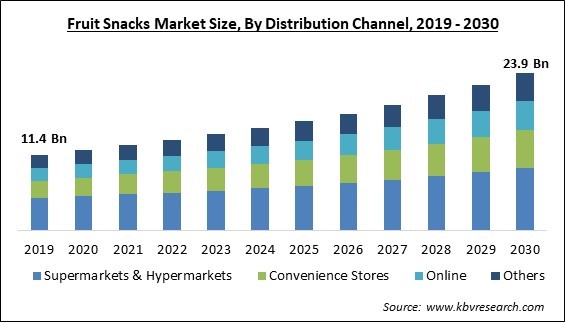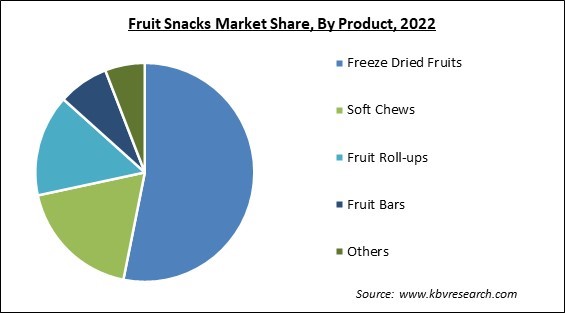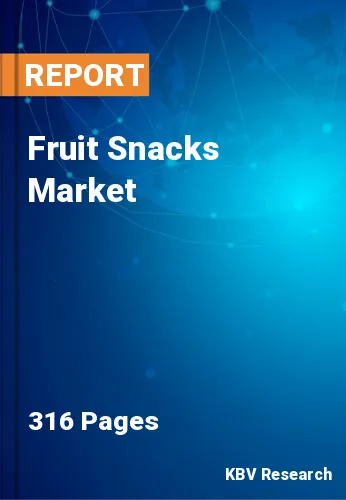The Global Fruit Snacks Market size is expected to reach $23.9 billion by 2030, rising at a market growth of 7.3% CAGR during the forecast period.
Banana chips are becoming widely popular among buyers of dried fruit chips. Therefore, the Banana segment is expected to acquire more than 1/5th share of the market by 2030. Sliced bananas that have been deep-fried or baked are used to make banana chips. They are frequently offered as sides or appetizers. The banana fruit snacks are growing due to the enormous demand from millennials and emerging markets. Key growth drivers in the market are technological advancements that enable effective operational maintenance, expanding product portfolio, sophisticated design and packaging, and sales monitoring. Some of the factors impacting the market are rising snacking culture globally, growing demand for Low-Calorie fruit snacks, and fluctuations in prices.

Consumers have become more aware of their diet and nutrition when they snack. People are searching for snacks that give both fun and some health advantages. Fruit snacks, which are frequently produced from fresh fruit with little processing, are seen as a healthier alternative to common snack items like chips or cookies. The needs of those concerned about their health are met by the accessibility of fruit snacks that are minimal in fat, calories, and added sugars. Developing economies have seen a significant rise in per capita income in recent years. Due to rising disposable incomes and growing global fitness awareness, consumers spend more on premium, environmentally friendly goods like fruit-based meals. As a result of growing demand for fruit snacks with low calories, the market is estimated to grow.
However, fruit snacks are typically more expensive than artificial tastes or ingredients, especially when created with natural fruit or other high-quality components. Logistics & distribution could become more complex, affecting fruit snacks' shelf life and storage requirements. Unpredictable price adjustments can breed uncertainty and are expected to impede market expansion over the projected period.
By distribution channel, the market is divided into supermarkets & hypermarkets, convenience stores, online and others. The online segment projected a prominent revenue share in the market in 2022. The availability of a wide range of options is shaping online distribution. Online marketplaces have made it simpler for customers to purchase fresh fruit and related products from around the world and have given vendors access to a larger customer base. The simple accessibility of fruit snacks through various chain stores & retail channels, like Walmart, Tesco.com, and others, boosts market expansion.
By product, the market is classified into fruit roll-ups, freeze dried fruits, fruit bars, soft chews, and others. The fruit bars segment covered a considerable revenue share in the market in 2022. Fruit juice concentrates, sugars, water, acids, flavors, and other components are combined with fresh fruit juice or pulp and partially dehydrated before being reconfigured and frozen to create frozen fruit bars. Fruit bars that have been frozen are flavorful and nutritious. They contain minerals & vitamins, are abundant in fiber & carbs, and have a low-fat level.

Based on nature, the market is segmented into conventional and organic. In 2022, the conventional segment witnessed the largest revenue share in the market. Conventional fruit snacks may contain products treated with synthetic chemicals, pesticides, or fertilizers. They are often more accessible and frequently less expensive than organic fruit snacks. The market is growing in this segment due to comparatively low cost of these snacks making them affordable for middle income population.
On the basis of fruit type, the market is bifurcated into apple, mango, banana, pineapple, berries, mixed and others. The apple segment recorded a remarkable revenue share in the market in 2022. Since dried apple chips contain no water, they can be stored for up to a year when kept correctly in a cold, dry place. Apple fruit snacks are frequently spiced with cinnamon, honey, or other ingredients. These are becoming an increasingly popular option for many consumers because they are low in calories and fat.
| Report Attribute | Details |
|---|---|
| Market size value in 2022 | USD 13.8 Billion |
| Market size forecast in 2030 | USD 23.9 Billion |
| Base Year | 2022 |
| Historical Period | 2019 to 2021 |
| Forecast Period | 2023 to 2030 |
| Revenue Growth Rate | CAGR of 7.3% from 2023 to 2030 |
| Number of Pages | 316 |
| Number of Table | 500 |
| Report coverage | Market Trends, Revenue Estimation and Forecast, Segmentation Analysis, Regional and Country Breakdown, Companies Strategic Developments, Company Profiling |
| Segments covered | Product, Nature, Fruit Type, Distribution Channel, Region |
| Country scope | US, Canada, Mexico, Germany, UK, France, Russia, Spain, Italy, China, Japan, India, South Korea, Singapore, Malaysia, Brazil, Argentina, UAE, Saudi Arabia, South Africa, Nigeria |
| Growth Drivers |
|
| Restraints |
|
Region wise, the market is analyzed North America, Europe, Asia-Pacific, and LAMEA. In 2022, the North America region led the market by generating the highest revenue share. The younger generation in North America prefers fruit snacks. These snacks are a practical choice for kids because they come in various shapes, sizes, and fruit flavors. Some fruit snacks are shaped like well-known cartoon characters or animals to increase their attractiveness. These snacks are frequently promoted as a healthier alternative to conventional candies because they are produced with natural fruit juices and purees.
Free Valuable Insights: Global Fruit Snacks Market size to reach USD 23.9 Billion by 2030
The market research report covers the analysis of key stake holders of the market. Key companies profiled in the report include Seneca Foods Corporation, General Mills, Inc., SunOpta, Inc., Kellogg Company, Keurig Dr Pepper, Inc., Mount Franklin Foods, LLC, Welch Foods, Inc., Sunkist Growers, Inc., Crispy Green, Inc., Chaucer Foods Ltd. (Pilgrim Food Group PLC).
By Distribution Channel
By Product
By Nature
By Fruit Type
By Geography
The Market size is projected to reach USD 23.9 billion by 2030.
Growing Demand for Low-Calorie Fruit Snacks are driving the Market in coming years, however, Fluctuations in Prices may Hamper Growth restraints the growth of the Market.
Seneca Foods Corporation, General Mills, Inc., SunOpta, Inc., Kellogg Company, Keurig Dr Pepper, Inc., Mount Franklin Foods, LLC, Welch Foods, Inc., Sunkist Growers, Inc., Crispy Green, Inc., Chaucer Foods Ltd. (Pilgrim Food Group PLC).
The Freeze-Dried Fruits segment acquired maximum revenue share in the Global Fruit Snacks Market by Product in 2022; thereby, achieving a market value of $12.2 billion by 2030.
The Supermarkets & Hypermarkets segment is leading in the Global Fruit Snacks Market by Distribution Channel in 2022; thereby, achieving a market value of $9.5 billion by 2030.
The North America region dominated the Global Fruit Snacks Market by Region in 2022, and would continue to be a dominant market till 2030; thereby, achieving a market value of $8.0 billion by 2030.
Our team of dedicated experts can provide you with attractive expansion opportunities for your business.

